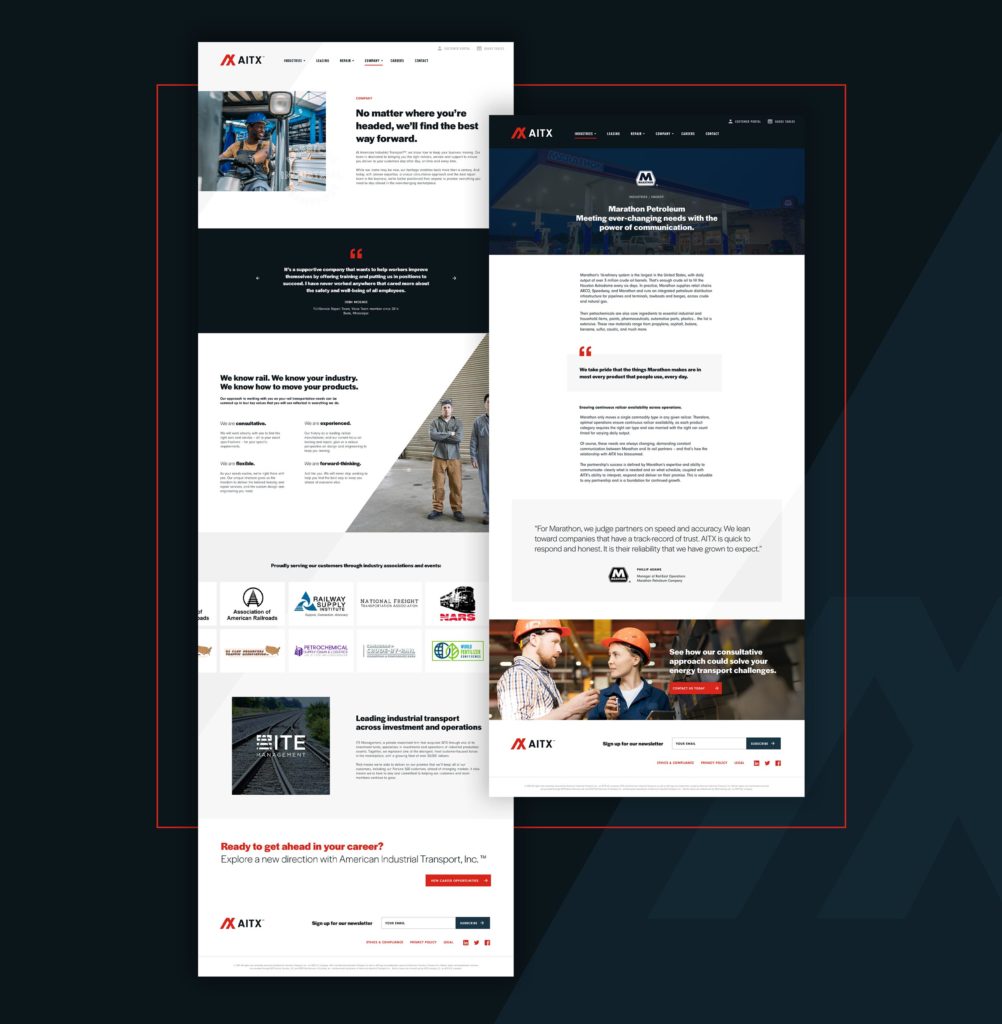Rebranding After a Merger: What Marketing Teams Need to Know
Companies are being built and sold faster than ever before. Every day, there are new startups, new products and new services. And every day, competitors join forces in the hopes of seizing an even larger share of the market.
But when companies go through mergers or acquisitions (M&A), cultures collide. One-time rivals are told to act like best friends. Sales departments feel disjointed because of differing approaches and leadership overlaps, and marketing managers struggle to fold existing product and service offerings into a cohesive brand story. No one wants to move too quickly, but the clock is ticking. If you can’t figure out your brand internally, how can you expect your customers to?

It’s natural for a marketing director—or anyone—to feel apprehensive about a brand in transition. The stakes are high, and it’s not easy to take two (or more) unique companies and make one unified brand identity. It’s even harder to build an entirely new brand that’s strong enough to gain preference in your customers’ eyes. But it isn’t impossible.
Here’s something nobody tells you about merger branding: it’s not really about the new brand or new logo.
I know that sounds backwards, especially coming from someone who makes a living helping companies with their brands. But after watching marketing teams navigate merger after acquisition after merger, I’ve learned the companies who get this right aren’t the ones with the prettiest new logos—they’re the ones who treat brand and brand strategy as a business function, not a creative project.
Because here’s the reality: while you’re debating color palettes and typography, your customers are trying to figure out if this merger means their world is about to get better or if it’s time to start shopping around.
The confusion problem in rebranding after a merger.
I love this great piece of advice from author Donald Miller: “If you confuse, you’ll lose.”
And mergers? They’re confusion factories by design. Two brands. Two websites saying different things. Two sets of everything. Two customer service numbers. Two ways of doing business that somehow need to become one without breaking anything important.
Your customers are watching this whole process, trying to decode what it means for them. Meanwhile, your employees are wondering if their job is safe and which email signature to use today. Everyone’s looking for signals about what’s really happening.
The brand story you tell during those first critical weeks isn’t marketing fluff—it’s a lifeline. It’s the difference between people thinking, “Finally, they’re going to be even better,” and “Oh great, time to switch companies.”
Getting buy-in during a brand transition.
When rebranding due to an acquisition or merger, your challenge begins internally. To combat dissidence within the organization, the first order of business is to get everyone (enthusiastically) on the same page about the new corporate identity.
The best way to do that is to identify key stakeholders within both organizations, tell them about the plans for rebranding, interview them and listen.
If you want external excitement about the new brand, you need to get internal buy-in first.

Internal launch plans, like this one we created for Premise Health, help energize employees and prepare companies for success after a merger.
And if you want internal buy-in for the eventual new brand, the best way is to get people involved early. You want them to feel like they’re part of the process, and that their voices matter. Because they do. And because that feeling of inclusion and goodwill will go a long way culturally and socially with team members from both companies.
Key people from both sides need to see themselves in the final brand you present. Even if their opinions aren’t entirely reflected in the final outcome, they will at least know that you listened and considered their perspective.
Securing brand’s seat at the decision table.
As Marty Neumeier puts it, “Most creative people don’t get a seat at the business table,” and during M&A, when everything feels like life or death, you’re sometimes lucky if teams remember to include marketers in important emails.
But marketing leaders needs to be a part of discussions relating to the business strategy—not just brought into conversations once decisions have been made.

 Above: When Lightedge and Connectria merged, Atomicdust created a new brand that reflects the new company’s direction and promise to clients.
Above: When Lightedge and Connectria merged, Atomicdust created a new brand that reflects the new company’s direction and promise to clients.
The integration team is making decisions that shape everything: which systems to keep, which processes to follow, which office locations stay open. Brand strategy should be part of that conversation, not something that gets figured out afterward.
You need someone with real decision-making power sitting in those meetings. Someone who can say “Hold on,” when the company is about to make a choice that might completely derail the new brand identity you’re building or blow up your customer’s experience.
Day 1 priorities for a merger or acquisition rebrand.
The most counterintuitive thing about rebranding after a merger? Don’t start with the visual rebrand.
I know. My designer heart breaks a little saying it.
But nobody cares how beautiful your new logo is if they can’t log into their account. Or if they don’t know whose name is on their paycheck. Or if the phone number they’ve been calling for three years suddenly goes to voicemail.
Day one is about proving that this merger isn’t going to break anyone’s world. Stability first. Story second. Visual identity third.
Customers need to see that nothing critical breaks. Employees need to know the company they joined still exists. Once those essentials feel rock-solid, you deliver the core narrative:
- Why the merger happened
- What’s in it for each audience
- What stays the same right now
The story you need is simple: why this happened, what’s in it for both internal and external audiences, and what stays the same. It goes for everyone: employees, customers, partners. It’s just framed a bit differently depending on who’s listening.

Above: When it rebranded after M&A activity, Momentus Technologies launched a site that gave background about the rebrand and showed how the company could serve audiences better than ever before.
Then comes the visual direction. The new logo, identity system, all the pieces that make it feel real. But the development happens in small steps: landing pages, new domain names, email announcement campaigns, and planning your social media rollout. Each piece builds on the last, so by the time you’re ready for the full reveal, you’ve already tested what works.
A logo is an empty vessel until you fill it with experience (according to the great designer and author Michael Beirut). So shift your focus to think about the experience from your customers’ perspective.
A story goes a long, long way.
When companies rebrand because of a merger or acquisition, they often change names, design new logos, and create new brand assets: sales materials, brochures, their website and just about everything else. But it’s important to remember that the visual components of the brand are just vehicles to carry something greater. Your brand story.

Above: New language created after Lightedge and Connectria merged excites internal and external audiences about the company’s next chapter.
People need a rallying cry. And when you’re combining teams, you’re going to need a good one. Staff need to know what they’re fighting for. What’s the thing that’s going to make them excited to get out of bed every day?
Rebranding efforts should focus on core brand messaging, including positioning language and supporting points. You need deceptively simple pieces, like a compelling elevator pitch that any person throughout the organization can offer up when a customer asks, “What does this mean for me?”
Why your rebranding rollout strategy really, really matters.
It’s a great feeling when our clients are so excited about the new brand we’ve developed that they want to roll it out right away, before all the supporting materials (emails, landing pages, website, sales slicks) have been created—or even fully planned.
But I’ve watched this play out enough times to see the pattern. The teams that nail their rebranding after a merger aren’t just focused on the new visual identity or launching the brand right away. The teams that consider messaging from all angles, and coordinate the brand launch in a comprehensive way, are measurably more successful.
To get staff excited about the new visuals and messaging, make internal communications a priority. Try town hall-style events to launch the brand. (In-person is great, but virtual can work well for remote and global teams.)

Above: When two competitors merged to become SimiTree, a comprehensive and meticulously timed brand rollout accompanied the merger announcement, allowing internal teams to immediately use and uphold the new brand in their interactions with clients and prospects.
Give employees clear milestones that explain what’s happened, what’s next, and when they’ll be expected to start using (and living) the new brand. Sometimes people need a scoreboard to know that the game has started. If you have remote teams all over the world, plan on deploying frequent, regular communications like email newsletters or messages from executives to build familiarity.
Customers stick around after successful rebrand rollouts because they’re not confused about what’s happening. Employees rally around something bigger than their anxiety about change. Sales teams have something coherent to sell instead of trying to explain why there are two of everything.
The company sees revenue growth because the story makes sense. Integration happens faster because everyone’s moving toward the same vision. Investors see proof that this wasn’t just financial engineering, it was about building something better.
The human side of merger math.
Here’s what I’ve learned from working with companies going through M&A: the spreadsheets might make perfect sense to the people who built them, but real people are scared.
Your employees are wondering if their job is safe. Your customers are wondering if their favorite product or reliable service is going away. Everyone’s trying to figure out if the company they trusted is about to become something they don’t recognize.
Developing the new brand isn’t just about logos and color schemes. It’s about being the calm voice in the storm. It’s about showing up with clarity when everything else feels like chaos.
And when you get this right, something beautiful happens. Instead of two separate companies trying to figure out how to work together, you get one story that everyone can believe in. A rallying cry. One future worth building toward.
Brand informing strategy, strategy informing brand.
The companies that succeed at rebranding after M&A activity understand something fundamental: this isn’t about creating the world’s most beautiful brand. It’s about creating a brand that helps the business work better.
That means treating brand decisions like business decisions. It means measuring success the same way you’d measure any other critical business function. It means understanding that confused customers don’t buy, confused employees don’t perform and confused markets don’t trust.
Most importantly, it means recognizing that good branding isn’t decoration—it’s the story that helps everyone make sense of the change.
“Under new management.”
Your customers will need to be convinced that the merger is designed to make their lives better—not just to make the company more money. Communicating the vision of the new company with customers is important for not only for generating new business, but for keeping customers.
If there’s any one thing that will get customers to reconsider their use of a product or service, for better or for worse, it’s the term “new management.” That’s why it’s important that you take control of the message before your competition does.
 Above: Atomicdust helped AITX drive internal adoption with a landing page explaining the new brand, and educate external audiences with a new site that clearly communicates the company’s vision and addressed potential concerns about the change.
Above: Atomicdust helped AITX drive internal adoption with a landing page explaining the new brand, and educate external audiences with a new site that clearly communicates the company’s vision and addressed potential concerns about the change.
Rebranding due to M&A activity can be a daunting, political process. But it can be done, and it can be done really well. When done correctly, it’s a golden opportunity to unify cultures, improve the customer relationship and strengthen a company’s position in the market.
Going through a merger and need help with your brand strategy?
Atomicdust has helped companies across industries navigate rebranding after M&A activity more times than we can count.
Let’s grab coffee and talk through your situation. We bring the strategic thinking, business acumen and creative vision you’ll need to make it work.



